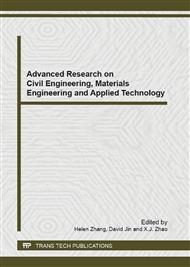[1]
R. A. Newcombe and A. J. Davison. Live dense reconstruction with a single moving camera. In Proc 28th IEEE Conf on Computer Vision and Pattern Recognition, (2010).
DOI: 10.1109/cvpr.2010.5539794
Google Scholar
[2]
J. M. Carranza and A. Calway. Efficiently increasing map density in visual SLAM using planar features with adaptive measurement. In Proc 20th British Machine Vision Conference, (2009).
DOI: 10.5244/c.23.43
Google Scholar
[3]
R. O. Castle and D. W. Murray. Object recognition and localization while tracking and mapping. In Proc 8th IEEE/ACM Int Symp on Mixed and Augmented Reality, pages 179–180, (2009).
DOI: 10.1109/ismar.2009.5336477
Google Scholar
[4]
H. Goto, Y. Hasegawa, and M. Tanaka, Efficient Scheduling Focusing on the Duality of MPL Representatives, Proc. IEEE Symp. Computational Intelligence in Scheduling (SCIS 07), IEEE Press, Dec. 2007, pp.57-64, doi: 10. 1109/SCIS. 2007. 357670.
DOI: 10.1109/scis.2007.367670
Google Scholar
[5]
E. Eade and T. Drummond. Scalable monocular SLAM. In Proc 24th IEEE Conf on Computer Vision and Pattern Recognition, pages 469–476, (2006).
DOI: 10.1109/cvpr.2006.263
Google Scholar
[6]
A. P. Gee, D. Cheklov, W. Mayol, and A. Calway. Discovering planes and collapsing the state space in visual SLAM. In Proc 18th British Machine Vision Conference, (2007).
DOI: 10.5244/c.21.6
Google Scholar
[7]
G. Klein and D. W. Murray. Improving the Agility of Keyframe-Based SLAM. In Proc 10th European Conf on Computer Vision, (2008).
DOI: 10.1007/978-3-540-88688-4_59
Google Scholar
[8]
S. Wangsiripitak and D. W. Murray. Avoiding moving outliers in visual slam by tracking moving objects. In Proc 2009 IEEE Int Conf on Robotics and Automation, (2009).
DOI: 10.1109/robot.2009.5152290
Google Scholar
[9]
A. J. Davison, I. D. Reid, N. D. Molton, and O. Stasse. MonoSLAM: Real-time single camera SLAM. IEEE Transactions on Pattern Analysis and Machine Intelligence, 26(6): 1052–1067, (2007).
DOI: 10.1109/tpami.2007.1049
Google Scholar
[10]
G. Klein and D. W. Murray. Parallel tracking and mapping for small AR workspaces. In Proc 6th IEEE/ACM Int Symp on Mixed and Augmented Reality, (2007).
DOI: 10.1109/ismar.2007.4538852
Google Scholar
[11]
E. Rosten and T. Drummond. Machine learning for high-speed corner detection. In Proc 9th European Conf on Computer Vision, (2006).
Google Scholar


